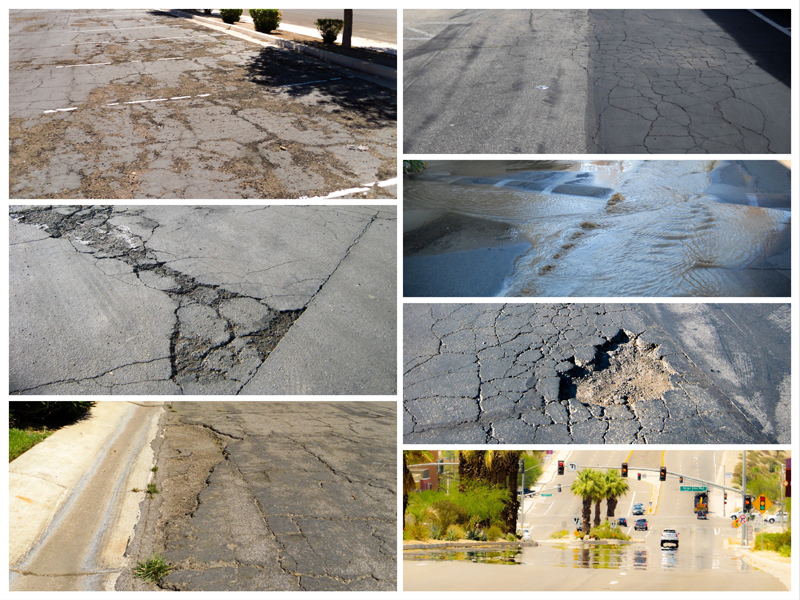
We have high expectations when it comes to the life of our asphalt pavement. It is almost always the most expensive asset to replace. The Reserve Study often states this major common area component has a 25-year lifespan, prompting us to ask “what happened?” when asphalt does not live up to this expectation. Is the quality of the asphalt to blame? While in rare instances there can be issues with the asphalt mix itself, the cause of failure usually lies elsewhere. So, if the asphalt itself is not to blame, what is the cause of the failure?
Let’s start by realizing that asphalt is designed to have a useful life. Over time there will be wear and deterioration. All pavement surfaces eventually wear out and require replacement; the goal is to allow for the pavement to wear out on time and not fail prematurely. There are multiple possible reasons why asphalt pavement fails prematurely, some of the most common causes are:
- Subgrade or base failure. The National Association of County Engineers states that “roads wear out from the top down, but they fall apart from the bottom up.” Asphalt is a strong and flexible product, but it is only as strong as the base supporting it. Sandy soils provide little strength and allow for movement of the asphalt. Clay soils hold moisture, damaging the support structure for the asphalt pavement. Once the subgrade has lost its strength, the asphalt surface above will fail. Installing a section of base material (or, in some cases, geotextile grid) can help create a stable base structure to support new asphalt pavement.
- Traffic load design. Community associations are not designed to handle the same traffic load as city streets or highways. The average weight of a compact car is about 2,979 pounds and a large SUV weighs an average of 4,366 pounds; this is the traffic load that the pavement is typically designed to handle during initial design and construction. During the life of the asphalt, much heavier vehicles will often use these streets for deliveries, emergencies, moving, construction, property maintenance, and refuse disposal. Titan Recycling states that trash and recycling trucks typically weigh between 40,000 pounds and 64,000 pounds when fully loaded. Over time, one loaded dump truck creates the same damage to asphalt paving as approximately 9,300 cars. It is common to see the first signs of pavement failure near trash enclosures so some refuse companies offer lighter vehicles that may help deter these damages. Concrete pads at trash enclosures or a stronger pavement section may be required to prevent future damages.
- Earthquakes and ground movement. California is a state in motion and there are over 140 fault lines in Southern California alone. According to earthquaketrack.com as of January 6th, 2022, Southern California experienced 4,622 earthquakes in the past 365 days. This shifting of the earth can and will cause cracks to appear allowing for water to penetrate and lead to premature pavement failure. There is not much that can be done to mitigate the damages caused by earthquakes as they are a part of the geographical landscape we call home.
- Temperature and weather. Extreme heat and cold create expansion and contraction in the pavement. You will often see cracks extend form concrete manhole covers or water valves because concrete has a different expansion rate than the asphalt pavement. Water freezing beneath the surface will cause the subgrade to expand and heave, creating cracks in the asphalt surface. Intense heat will accelerate the deterioration of the oils in the pavement making the asphalt brittle and susceptible to cracking. Proper maintenance will help deter the damaging effects of the weather.
- Reflective cracking. If a new layer of asphalt is installed over existing cracks, there is little or no support for the new pavement provided by the cracks below. The result is called reflective cracking. These cracks are inevitable and may appear within the first month after an asphalt overlay is completed. Remember: “roads fall apart from the bottom up.” The failure below needs to be addressed to prevent future cracking. Reflective cracks will also allow water to penetrate the pavement structure causing further damages. Whenever possible, cracked and broken asphalt should be removed and replaced with new asphalt pavement on top of a solid foundation.
- Excessive water. Water is the number one cause of asphalt failure. That is usually due to subgrade material becoming saturated and unstable. In some geographical locations, underground springs or rising water tables will affect the subgrade and thus the life of the pavement. Water washing over the surface is also damaging. Misdirected sprinklers and poor drainage will allow water to slowly wash away the fine materials allowing for the larger aggregate to break free. Keep an eye out for moisture on or around your asphalt and take necessary action to prevent further damages.
This is not an all-inclusive list, but each of these factors can play a role in premature asphalt failure. Remember that all pavement will eventually wear out; premature failure is when it wears out earlier than anticipated. Now is a good time to work with your asphalt professional to be sure you are getting the best performance possible out of your asphalt.
